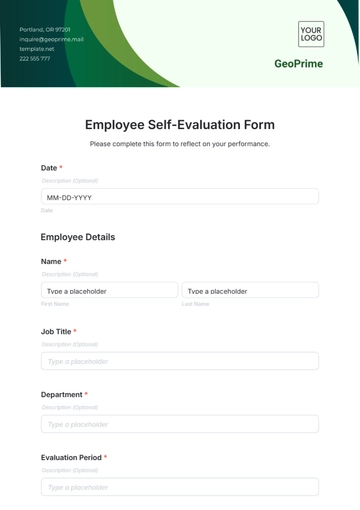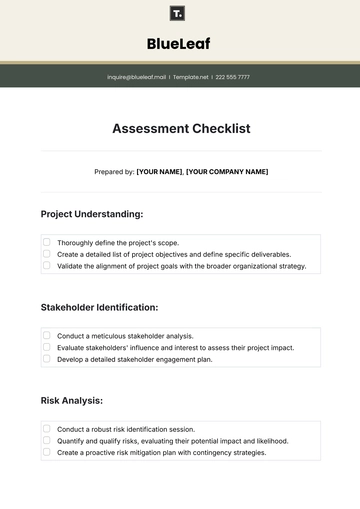Free Legal Corporate Compliance Impact Assessment Study

I. Introduction:
[Your Company Name], a leading provider in [industry/sector], recognizes the critical importance of maintaining compliance with legal and regulatory requirements to ensure ethical operations, mitigate risks, and uphold the trust of our stakeholders. In light of this commitment, we have undertaken a comprehensive Legal Corporate Compliance Impact Assessment Study to assess the impact of relevant laws, regulations, and industry standards on our operations and to enhance our compliance framework.
II. Legal and Regulatory Analysis:
As a cornerstone of our Legal Corporate Compliance Impact Assessment Study, we have conducted a meticulous analysis of the legal and regulatory landscape governing [Your Company Name]'s operations. Our analysis spans multiple jurisdictions and encompasses a broad spectrum of laws, regulations, industry standards, and contractual obligations relevant to our industry sector.
Identification of Applicable Laws and Regulations:
We have identified and compiled a comprehensive list of all relevant laws and regulations that directly impact our business operations. This includes statutory laws, regulatory requirements issued by governmental agencies, international standards, and industry-specific guidelines. Our analysis extends to areas such as data privacy (e.g., GDPR, CCPA), environmental regulations (e.g., EPA regulations, EU Emissions Trading System), labor laws (e.g., FLSA, FMLA), product safety standards (e.g., FDA regulations, CE marking), and industry-specific regulations (e.g., HIPAA for healthcare, FINRA regulations for financial services).
In-depth Examination of Legal Requirements:
Each identified law and regulation has undergone a detailed examination to understand its scope, applicability, and specific compliance requirements. This involves analyzing statutory provisions, regulatory guidelines, case law precedents, and any recent amendments or updates.
Jurisdictional Analysis:
Given the global nature of our operations, we have conducted a jurisdictional analysis to assess the variations and nuances in legal requirements across different geographical regions. This includes understanding the extraterritorial reach of certain laws, potential conflicts of laws, and regulatory compliance requirements unique to specific jurisdictions.
Regulatory Compliance Frameworks:
We have evaluated the regulatory compliance frameworks established by relevant regulatory bodies or industry associations. This includes reviewing regulatory guidance documents, compliance checklists, and best practices aimed at assisting organizations in meeting their compliance obligations.
Contractual Obligations:
In addition to statutory and regulatory requirements, we have reviewed our contractual obligations with customers, suppliers, partners, and other stakeholders. This involves examining contractual terms, service-level agreements, confidentiality clauses, and any compliance-related provisions to ensure alignment with external legal requirements.
Emerging Regulatory Trends and Developments:
Our analysis extends beyond existing legal requirements to include an assessment of emerging regulatory trends, legislative developments, and regulatory initiatives that may impact our business in the future. This proactive approach enables us to anticipate regulatory changes and adapt our compliance strategies accordingly.
III. Risk Assessment:
In conducting the risk assessment phase of our Legal Corporate Compliance Impact Assessment Study, we have undertaken a thorough examination of potential risks associated with non-compliance with legal and regulatory requirements. This process is essential for [Your Company Name] to identify, prioritize, and mitigate risks effectively, safeguarding our reputation, operations, and stakeholders' interests.
Identification of Compliance Risks:
Our first step involved identifying a wide range of compliance risks that could arise from failure to adhere to applicable laws and regulations. These risks encompass legal liabilities, financial penalties, reputational damage, operational disruptions, and loss of stakeholder trust. We categorized risks based on their likelihood and potential impact on our business activities.
Regulatory Enforcement Risks:
We assessed the risk of regulatory enforcement actions, including fines, penalties, sanctions, and legal proceedings, resulting from non-compliance with specific legal and regulatory requirements. This involves analyzing enforcement trends, regulatory priorities, and precedents in relevant jurisdictions to gauge the potential consequences of compliance failures.
Operational Risks:
Compliance failures can pose significant operational risks, including disruptions to production processes, supply chain interruptions, delays in product launches, and damage to critical assets or infrastructure. We evaluated the operational implications of compliance requirements to identify vulnerabilities and areas where operational resilience may be compromised.
Reputational Risks:
Maintaining trust and credibility with stakeholders is paramount for [Your Company Name]. We assessed the risk of reputational damage resulting from negative publicity, media scrutiny, consumer backlash, and loss of goodwill due to non-compliance incidents. Understanding the reputational risks associated with compliance failures enables us to proactively protect our brand reputation and stakeholder relationships.
Financial Risks:
Compliance failures can have significant financial implications, including monetary penalties, legal fees, regulatory fines, and loss of revenue. We conducted a financial risk assessment to quantify the potential costs of non-compliance and evaluate their impact on [Your Company Name]'s financial performance, profitability, and shareholder value.
Third-Party Risks:
Our operations involve interactions with various third parties, including suppliers, vendors, contractors, and business partners. We assessed the risks of third-party non-compliance, such as supply chain risks, vendor management risks, and contractual non-compliance risks, which could expose [Your Company Name] to compliance vulnerabilities and liabilities.
Emerging Risks:
In addition to known compliance risks, we considered emerging risks arising from technological advancements, regulatory changes, geopolitical developments, and other external factors. This proactive approach enables us to anticipate and mitigate risks before they escalate into compliance issues.
IV. Gap Analysis:
In the Gap Analysis phase of our Legal Corporate Compliance Impact Assessment Study, we conducted a detailed comparison of our current compliance practices, policies, and procedures against the requirements outlined in relevant laws, regulations, industry standards, and contractual obligations. This process is instrumental in identifying areas where our compliance efforts may fall short and where improvements are needed to align with external legal and regulatory requirements.
Identification of Compliance Requirements:
We began by compiling a comprehensive list of compliance requirements derived from the legal and regulatory analysis conducted in the previous phase. These requirements encompass statutory laws, regulatory guidelines, industry standards, contractual obligations, and other relevant mandates applicable to [Your Company Name]'s operations.
Assessment of Current Compliance Practices:
Next, we evaluated our existing compliance practices, policies, and procedures to understand how they align with identified compliance requirements. This involved reviewing documentation, interviewing key stakeholders, and conducting walkthroughs of relevant processes to gain insights into our current compliance framework.
Identification of Compliance Gaps:
By comparing our current compliance practices against the identified compliance requirements, we identified areas where gaps exist. These gaps may manifest as deficiencies in policies and procedures, inadequate controls, insufficient training and awareness programs, or other shortcomings that hinder our ability to fully comply with legal and regulatory obligations.
Quantification and Prioritization of Gaps:
We quantified the severity and significance of each identified compliance gap based on factors such as the potential impact on business operations, the likelihood of non-compliance, and the level of regulatory scrutiny. This prioritization process enabled us to focus our resources on addressing high-risk gaps that pose the greatest threat to [Your Company Name]'s compliance objectives.
Root Cause Analysis:
In addition to identifying compliance gaps, we conducted a root cause analysis to understand the underlying reasons behind each gap. This involved examining factors such as organizational structure, resource constraints, communication breakdowns, and cultural barriers that may contribute to compliance deficiencies.
Documentation of Findings:
We meticulously documented our findings from the gap analysis, including a detailed description of each identified compliance gap, its root causes, and its potential implications for [Your Company Name]. This documentation serves as a foundation for developing targeted remediation plans and implementing corrective actions.
Recommendations for Improvement:
Based on the findings of the gap analysis, we developed recommendations for addressing identified compliance gaps and strengthening our overall compliance framework. These recommendations are tailored to the specific needs and challenges of [Your Company Name] and are designed to facilitate continuous improvement in our compliance practices.
V. Operational Impact Assessment:
In the Operational Impact Assessment phase of our Legal Corporate Compliance Impact Assessment Study, we meticulously evaluated how compliance requirements impact [Your Company Name]'s day-to-day operations, processes, and systems. This assessment is crucial for understanding the practical implications of compliance on our business activities and ensuring that our operations remain efficient, resilient, and aligned with regulatory obligations.
Review of Key Operational Processes:
We began by reviewing key operational processes and workflows across various departments and business units within [Your Company Name]. This included examining processes related to production, procurement, sales, marketing, finance, human resources, IT, and other functional areas.
Identification of Compliance Touchpoints:
Next, we identified compliance touchpoints within each operational process where legal and regulatory requirements intersect with our business activities. These touchpoints may include data handling procedures, reporting requirements, quality control measures, employee training protocols, and customer interaction processes.
Assessment of Compliance Impacts:
We assessed how compliance requirements impact each identified touchpoint within our operational processes. This involved evaluating factors such as workflow efficiency, resource allocation, timing constraints, information management practices, and stakeholder communication channels.
Quantification of Operational Impacts:
We quantified the operational impacts of compliance requirements by analyzing metrics such as process cycle times, resource utilization rates, error rates, downtime incidents, and customer satisfaction scores. This quantitative analysis provided insights into the tangible effects of compliance on our operational performance.
Identification of Operational Challenges:
Through our assessment, we identified operational challenges and barriers that may arise from compliance requirements. These challenges may include increased administrative burdens, complexity in process execution, technology limitations, skill gaps among employees, and resistance to change within the organization.
Risk Mitigation Strategies:
We developed risk mitigation strategies to address operational challenges and minimize disruptions resulting from compliance requirements. These strategies may involve process redesign, automation of compliance tasks, investment in technology solutions, enhancement of employee training programs, and realignment of organizational structures.
Integration of Compliance into Operations:
We explored opportunities to integrate compliance considerations seamlessly into our operational processes to promote a culture of compliance throughout [Your Company Name]. This includes embedding compliance requirements into standard operating procedures, performance metrics, employee KPIs, and decision-making frameworks.
Continuous Improvement Initiatives:
Finally, we identified opportunities for continuous improvement in our operational processes to enhance compliance effectiveness and operational efficiency over time. This involves establishing feedback mechanisms, conducting regular performance reviews, and fostering a culture of innovation and learning within the organization.
VI. Resource Assessment:
In the Resource Assessment phase of our Legal Corporate Compliance Impact Assessment Study, we conducted a comprehensive evaluation to determine the resources required to achieve and maintain compliance with relevant laws, regulations, and industry standards. This assessment is essential for [Your Company Name] to allocate resources effectively, ensure sufficient support for compliance initiatives, and enhance our overall compliance readiness.
Identification of Resource Categories:
We began by identifying the various resource categories necessary to support our compliance efforts. These may include financial resources, human resources, technological infrastructure, training and development programs, external expertise, and other resources critical for implementing and sustaining compliance initiatives.
Financial Resource Assessment:
We evaluated the financial resources required to support our compliance activities, including budget allocations for compliance-related expenses such as regulatory fees, legal consultations, technology investments, audit costs, insurance premiums, and remediation efforts. This assessment helped us determine the financial implications of compliance and budget accordingly.
Human Resource Assessment:
We assessed the human resources needed to execute our compliance strategies effectively. This involved evaluating the availability of skilled personnel, assessing staffing levels, identifying key roles and responsibilities within the compliance function, and determining training and development needs to enhance employees' compliance competencies.
Technological Resource Assessment:
Given the increasing reliance on technology in compliance management, we evaluated our technological infrastructure and capabilities to support compliance initiatives. This included assessing the adequacy of our IT systems, data management practices, cybersecurity measures, compliance monitoring tools, and other technological resources essential for compliance.
Training and Development Assessment:
We assessed the training and development needs of our workforce to enhance their awareness, knowledge, and skills related to compliance requirements. This involved identifying gaps in employee competencies, developing targeted training programs, providing access to compliance resources and materials, and fostering a culture of continuous learning.
External Expertise Assessment:
We evaluated the need for external expertise and support to supplement internal resources in addressing complex compliance challenges. This may include engaging external consultants, legal advisors, auditors, industry associations, and other experts to provide specialized knowledge, guidance, and assistance in navigating regulatory requirements.
Resource Optimization Strategies:
We developed resource optimization strategies to maximize the efficiency and effectiveness of our compliance efforts. This may involve streamlining processes, leveraging technology solutions, outsourcing non-core compliance activities, cross-training employees, and adopting cost-effective compliance management practices.
Resource Allocation Planning:
Based on the resource assessment findings, we developed a resource allocation plan to ensure that adequate resources are allocated to priority areas of compliance. This plan considers the strategic importance of compliance objectives, the level of risk associated with non-compliance, and the available resources within [Your Company Name].
VII. Recommendations:
Based on our analysis, we have developed recommendations to address identified compliance gaps, mitigate risks, and enhance our overall compliance posture. These recommendations are tailored to the specific needs and challenges of [Your Company Name].
Conduct regular compliance training sessions for all employees to ensure awareness of relevant laws, regulations, and company policies.
Implement robust document management procedures to maintain accurate records and evidence of compliance activities.
Establish a dedicated compliance team responsible for monitoring regulatory changes, conducting internal audits, and enforcing compliance standards.
Develop and implement a whistleblower policy to encourage reporting of potential compliance violations without fear of retaliation.
Enhance IT security measures to protect sensitive data and ensure compliance with data privacy regulations.
Review and update contracts with suppliers, vendors, and partners to include compliance clauses and requirements.
Implement a risk management framework to identify, assess, and mitigate compliance risks across all business operations.
Conduct periodic reviews of internal controls and procedures to identify weaknesses and opportunities for improvement.
Establish clear channels of communication for employees to seek guidance and report compliance concerns or ethical dilemmas.
Engage with industry associations, legal experts, and regulatory bodies to stay informed about emerging compliance trends and best practices.
VIII. Conclusion:
In conclusion, the Legal Corporate Compliance Impact Assessment Study undertaken by [Your Company Name] provides valuable insights into our compliance landscape and lays the foundation for strengthening our compliance framework. By proactively addressing compliance risks and implementing robust measures, we are committed to upholding the highest standards of ethical conduct and governance across our organization.
- 100% Customizable, free editor
- Access 1 Million+ Templates, photo’s & graphics
- Download or share as a template
- Click and replace photos, graphics, text, backgrounds
- Resize, crop, AI write & more
- Access advanced editor
Evaluate compliance impact with Template.net's Legal Corporate Compliance Impact Assessment Study Template. This editable and customizable template, available on Template.net alongside our AI Editor Tool, provides a structured framework to analyze regulatory changes, identify compliance risks, and develop strategies to mitigate potential impacts on business processes and objectives. Navigate compliance effectively with Template.net!





























